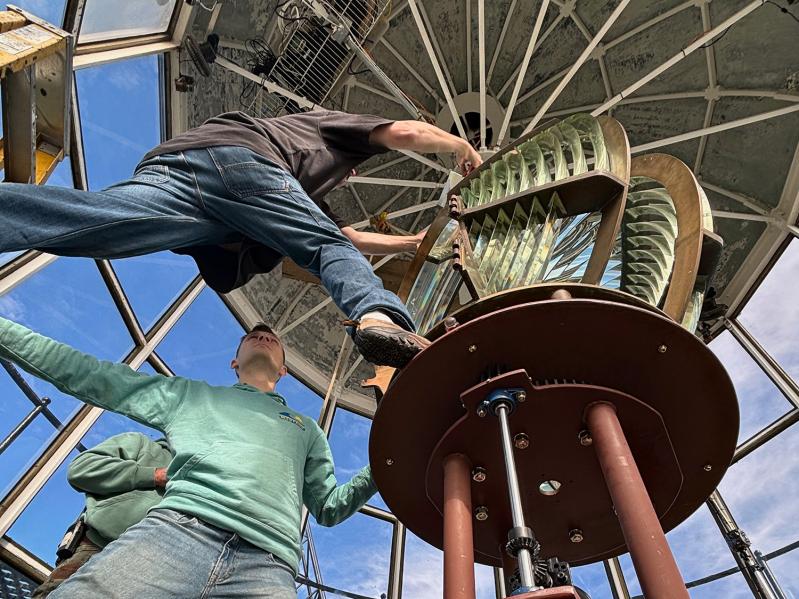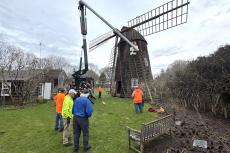It was particularly dark at Montauk Point shortly before 6 on Monday evening as a small crowd gathered near the Lighthouse gate under a still-moonless sky for an event that was years, some might even say decades, in the making.
As the clock turned to 6 on the nose, there was a flicker, then another and another and then, emanating from the Lighthouse tower, came two rotating beams of light to pierce the night sky with a strength not seen since the 1980s. The Montauk Lighthouse’s 3 1/2 order Fresnel lens, long relegated to the position of prized museum artifact, was back in its rightful place atop the tower.
The lens, manufactured especially for the Montauk Lighthouse in 1902 by the French company Barbier, Bénard, and Turenne, had served as a beacon for mariners from 1903 until 1987, when the Coast Guard replaced it with easier-to-maintain light sources: first a runway light and later a dimmer lamp to save energy and money.
“The lights on the exterior of the building were brighter than the light in the tower,” said Mia Certic, executive director of the Montauk Historical Society, which owns and maintains the Lighthouse, while the Coast Guard maintains the light itself, as well as the foghorn.
It’s true that with the rise of GPS, the light itself became less important as a navigational aid, but “we felt the lack of it,” Ms. Certic said. “I think our fishing community felt the lack of it.” And people who remembered the beacon as it had once been missed the familiar sweep of light spinning predictably from sunset to sunrise, visible many miles from shore and as far away as East Hampton on a clear, dark night.
Since 1987 the Fresnel lens has been at the Montauk Lighthouse Museum, where pharologists (that’s a fancy word for lighthouse enthusiasts) could see its craftsmanship up close. This one is a 3 1/2 order bivalve (or clamshell) flashing lens. The “order” of the lens refers to its size: There are six orders, with the largest being a first-order lens. The Fresnel lens at the Montauk Lighthouse is a rare one, Ms. Certic said.
Such lenses work by concentrating, focusing, and magnifying a light source, and they revolutionized lighthouse operation, according to the National Park Service, by allowing a single beam to reach all the way to the horizon. In days gone by, lighthouse keepers and Coast Guard lampists were responsible for maintaining the lenses. But as the official keepers and lampists have been phased out, so too have the lenses.
The return of the Fresnel lens to the top of the Montauk Lighthouse is part of a two-year pilot program to help the Coast Guard gather data about Fresnel lens “operation and condition in an environmentally controlled lantern room,” according to an article published Tuesday in United States Coast Guard News. It dovetails nicely with the recently completed renovation of the Lighthouse tower, and would not have been possible without it.
“We had to restore the tower, because we had a lot of moisture damage,” Ms. Certic said. “We didn’t know that we would get approval for this pilot program, but we just kept putting things in place” to make it possible.
“This pilot program is going to be extremely beneficial to the Coast Guard,” she said. There were once hundreds of Fresnel lenses in lighthouses across the country, but now only about 50 remain in service. And there are only five Coast Guard-approved lampists who can attend to them.
“We saw this as a unique opportunity,” Matthew Stuck, the Coast Guard’s First District waterways chief, said in a release from the historical society. Not only was the society eager to return the lens to the Lighthouse tower, but it was also willing to take on the daily tasks required to maintain it and the diligent recordkeeping required of the pilot program, the goal of which, according to Chief Stuck, is “to help us create new protocols for managing our Fresnels.”
A Coast Guard curator is responsible for all the antique lenses and for the contracts with the groups and individuals trusted with safeguarding them. The historical society, Chief Stuck said, “provided everything necessary to satisfy the Coast Guard curator’s requirements regarding temperature, humidity, and light control in the lantern room.”
The Fresnel lens had to be completely restored and the mercury removed from its pedestal. For this, the society brought in one of those five lampists — Jim Woodward from Arizona. The lantern room got new UV-light-filtering window film thanks to TriState Sun Control, while the tower needed a new ventilation system, designed and installed by SchroffTech, and state-of-the-art temperature, humidity, and dew-point monitors, provided by Avtech.
Kurt Fosburg, another Coast Guard-approved lampist from Michigan’s Upper Peninsula, designed and built a new pedestal and gear mechanism for the lens. The cost of all of this was largely covered by a $100,000 grant from the Ludwick Family Foundation of California.
The lens was moved back into the tower just over a week ago with the aid of a crane.
Now that it is fully operational, it falls to the historical society and its team at the Lighthouse to prove that the Fresnel lens is in good hands. Everyone who works or is involved there, from the site manager, Jason Walter, a former senior chief petty officer with the Coast Guard, to the docents, to Joe Gaviola, president of the society’s board and resident in the lighthouse keeper’s quarters, to Ms. Certic herself have received training from the lampists on “what to look for to make sure that everything is okay,” Ms. Certic said.
“Are there warning signs that something might be going wrong? If there’s an excessive amount of gray dust on the pedestal, the substance that holds the crystal in place might be degrading. There are certain noises to listen for, aside from the clanking of the machine. It needs to be dusted with a feather duster with some regularity, like every month or two. . . .”
All of this must be “done religiously for the two years of this project,” Ms. Certic said.
And after that?
The historical society is hoping that the Fresnel lens can remain atop the tower for good.
“Those of us who grew up in Montauk have tremendous affection for that bright, reassuring beam, so we’re especially happy that the Coast Guard is allowing us to participate in this exciting pilot program,” Richard White Jr., chairman of the Montauk Point Lighthouse Committee and a longtime advocate for returning the lens to the tower, said in a release. “We could not be more pleased to be able to allow a whole new generation the chance to experience the beautiful sweep of light that the Fresnel lens is famous for.”
Thousands of people will have a chance to admire it on the Saturday after Thanksgiving, when the historical society hosts its annual holiday Lighting of the Lighthouse just after dark.





